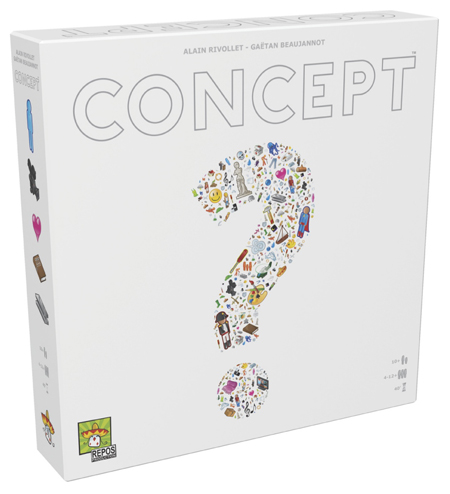“Charades“ has a lot of variants…”Pictionary”, “Heads Up!”, and “Guesstures” just to name a few. “Concept” is more like “Pictionary” in the sense that it’s visual intensive, though in this case, the pictures are already drawn for you. It’s up to players to convey the word or phrase using various picture icons along with tokens of varying shapes and colors. Before we go any further, I’d like to quickly thank Dominic Rouillier from Asmodee for providing me with a free press copy for review purposes.
Editor’s Note: The game can be played with two or three players if you modify the rules. More on that in the review section of this article.
Components
1 game board with universal icons, 5 sets of pawns and cubes, 110 concept cards, VP tokens, 4 player aids, and 1 bowl.
Setup & Gameplay
To set up the game, players place the board into the center of the table with the VP tokens placed nearby. The pawns and cubes go in the bowl. Finally, players choose who will be the starting “team” of two players.
At the beginning of a turn, the “team” draws a concept card and collectively chooses a word or phrase from the nine listed (three are “easy”, three are “hard”, and three are “challenging”). That team then places concept and sub-concept pawns along with cubes of varying colors onto the board to try and get the others to guess that word or phrase. The team may not speak, though they can say “yes” to encourage a particular line of thinking. The player who guesses correctly gets a double VP token (worth two points) while the two player team gets one VP token each. The role of the “team” is moved to the next two players clockwise.
When the double VP tokens are all awarded, the game ends. The player with the most VPs at this point, wins the game!
Editor’s Note: The above doesn’t cover all of the rules found in the manual, but should give you an idea as to how the game is played.
The Review
So here’s the thing…I found “Concept” to be a great idea (pardon the pun), though I did not like the default rules that were outlined in the manual. For example, the default rules mention nothing about extra points being awarded to players or teams who choose harder words or phrases. To be fair, the manual does list an aside by the developers that recommend that you play without points and/or try a variant that awards points based on word/phrase difficulty…though it leaves the rest up to you. This can be either a boon or curse, depending on how creative you and your gaming group are.
Personally, I liked the variant that “Table Top” recently featured on their YouTube channel…that is, players can cooperatively play against the game to reach a certain point limit. One player would take turns trying to convey to the others what the concept is…though you could pair off into teams IF you had enough players. Speaking of which, I mentioned above that the minimum player count of four could be adjusted if you introduced some variants. If you opt to not play for points, then one or two other people could simply take turns trying to convey words (or use the aforementioned co-op variant). I didn’t like the point system, as it tended to favor players who are familiar with what the different icons mean.
As far as the components go, I think everything was on or above par. I like the inclusion of cheat sheets to help players quickly see what the icons mean should they get lost. I also like the idea of sub-concepts with each having their own set of pawns/cubes, though it may take some practice to really use them to their full potential. “Concept” is a love it or hate it kinda game, what with so many “Charades” variants on the market. If you can’t draw (like me), then you’ll come to appreciate being given the tools you’ll receive to convey words or phrases creatively. Those who prefer to stand up and act out things may find this game to be a bit on the boring side. Honestly, it depends on the individual…luckily as mentioned above, “Concept” can be adjusted to cater to a variety of play-styles if you’re willing to break the rules and be creative.
Final Verdict: 8/10


